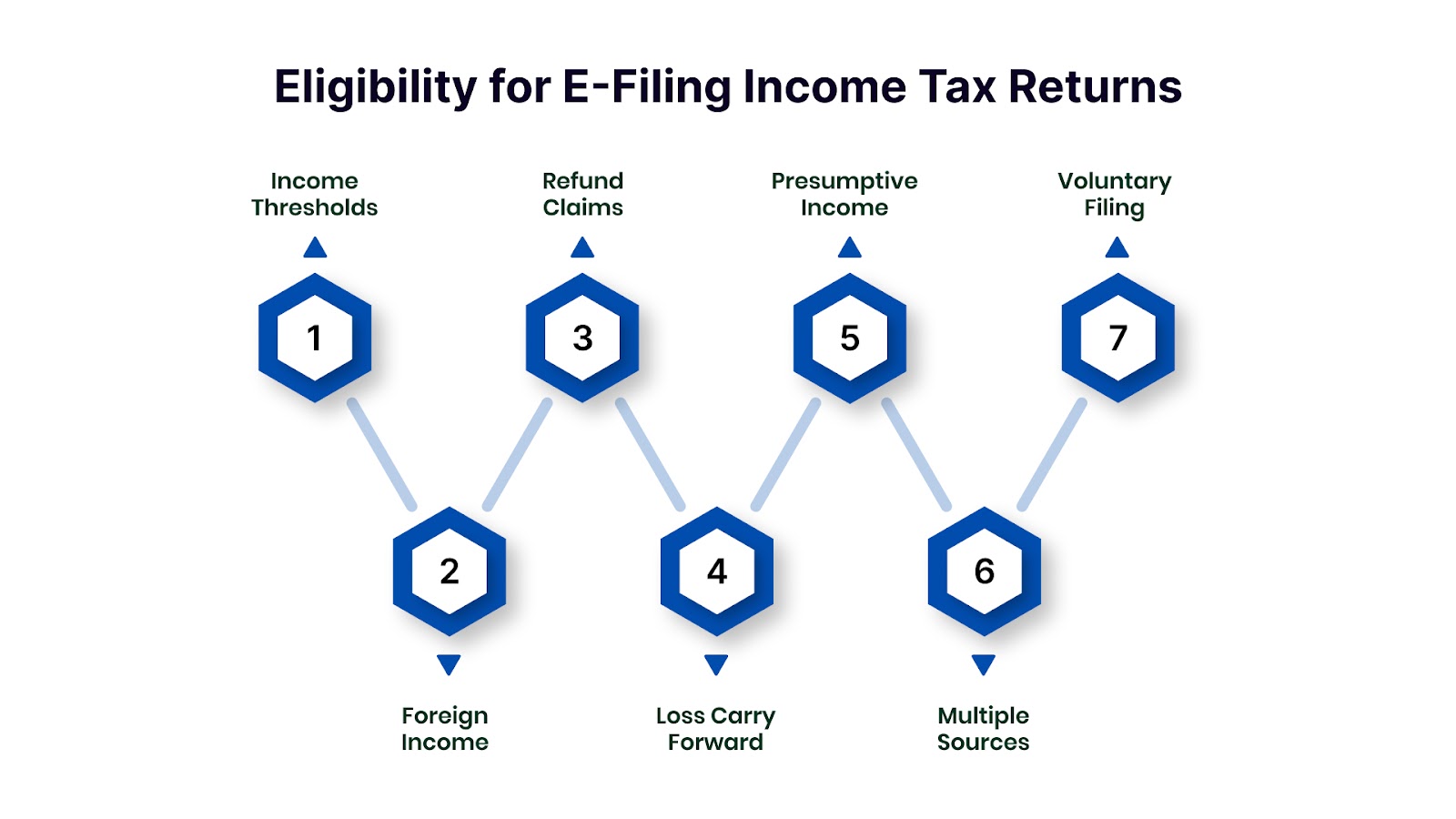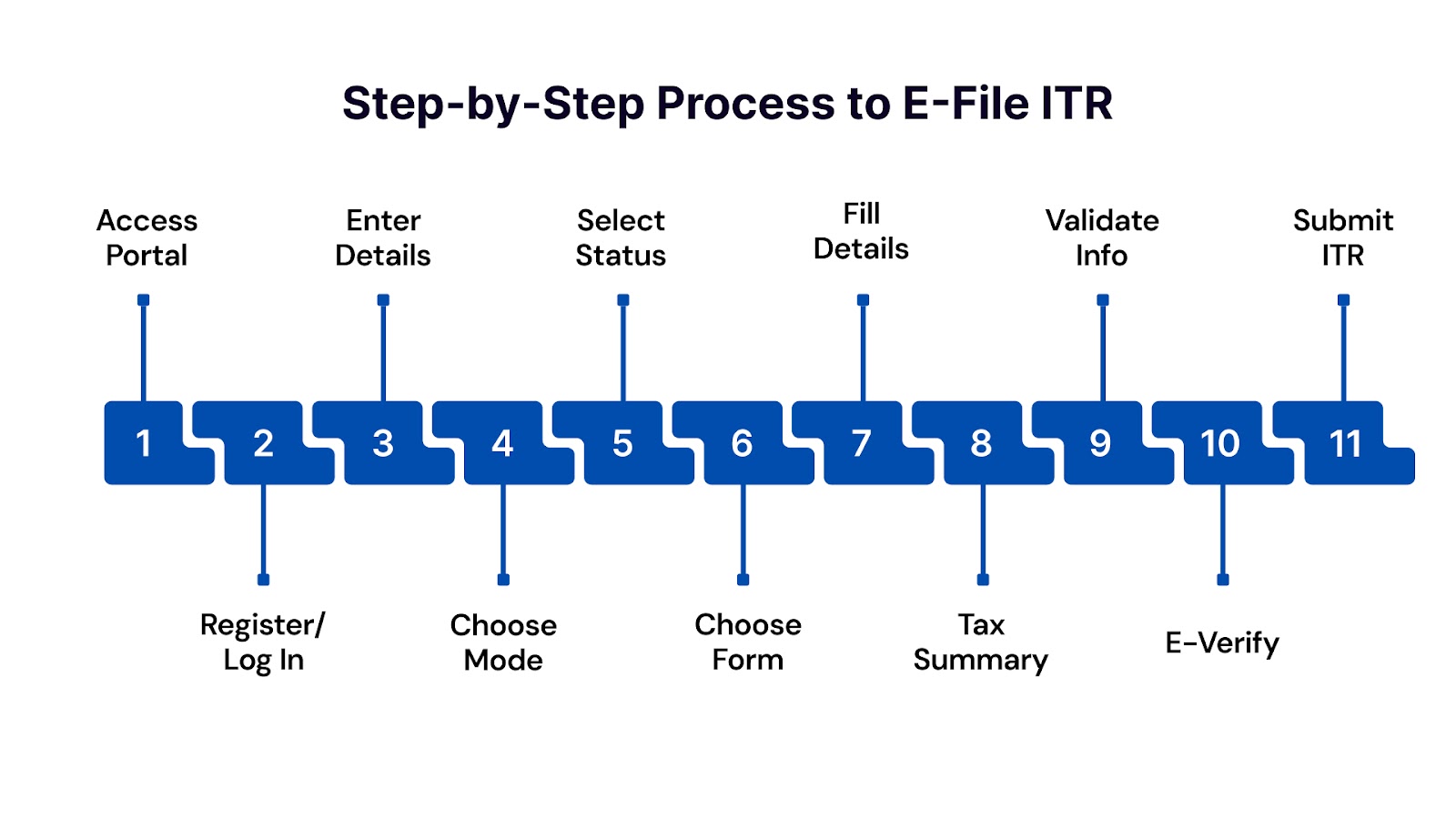July 21, 2025

As the traditional methods of filing income tax returns become obsolete, the Income Tax Department's e-filing portal has revolutionized the way taxpayers in India manage their tax obligations. Notably, in the financial year 2024-25, over 9.19 crore Income Tax Returns (ITRs) were filed, with more than 8.64 crore e-verified returns, highlighting a significant shift towards digital compliance.
The move towards e-filing is not just a trend but a reflection of the government's commitment to simplifying tax compliance. Enabling you to file your returns online not only makes tax filing simpler but also ensures compliance with the Income Tax Department’s rules, helping you avoid penalties or errors.
In this comprehensive blog, we will guide you through the entire e-filing process, explain its benefits, and provide a detailed step-by-step guide for seamless submission.
TL;DR (Key Takeaways)
E-filing of income tax returns refers to the process of filing your ITR digitally through the official Income Tax Department's e-filing portal. Instead of submitting a physical copy of your tax return, you can now file your returns electronically by uploading the necessary documents, filling out the required forms, and submitting them via the online platform.
This process has become a standard practice for taxpayers due to its ease, efficiency, and security. Moreover, it eliminates the need for physical paperwork and manual submissions, making the process more efficient and lucrative for taxpayers.
If you’re seeking efficiency and reliability in your tax filing process, e-filing your income tax returns offers numerous advantages over traditional paper-based filing methods:
E-filing your ITR ensures that your tax returns are filed on time, making you eligible for various benefits such as tax refunds. Furthermore, timely e-filing avoids penalties and helps keep your financial records in order for future reference or audits.
Now that you understand what e-filing is, the next crucial thing you need to determine is if you're actually eligible to file your returns electronically.

Before you begin e-filing your tax returns, it’s crucial to ensure you meet the eligibility criteria. While the Income Tax Act of 1961 mandates that individuals earning above a certain income threshold must file returns, the advent of e-filing has introduced specific criteria for online submission.
Let's delve into the detailed eligibility requirements to determine if you're ready to file your ITR online.
Under the old tax regime in the financial year 2025-2026, the Income Tax Act clearly specifies different income thresholds for individuals based on their total gross income, including the standard deduction, and their age:
Conversely, under the new tax regime, all individuals with total income exceeding ₹4 lakh must file ITR, irrespective of their age. These thresholds are applicable irrespective of the source of income, be it salary, business, or other sources.
If you’re an Indian resident but have income from foreign sources, you are required to file your returns electronically. This includes income from assets or financial interests located outside India, or if you have signing authority in any account located outside India.
If you are eligible for a tax refund, e-filing your ITR becomes mandatory for you. Filing electronically ensures faster processing and quicker refunds.
To carry forward losses under any head of income (such as house property loss or capital loss), it is essential to file your ITR within the prescribed due dates. E-filing facilitates this process and ensures your losses are carried forward to subsequent assessment years.
If you’re opting for the presumptive taxation scheme under sections 44AD, 44ADA, or 44AE, which simplifies the taxation of small businesses and professionals, you’re eligible to file your returns online using the ITR-4 form.
If you have income from multiple sources, such as salary, house property, capital gains, or other sources, you are eligible to file your ITR online. The e-filing portal accommodates various income combinations through different ITR forms.
Even if your income is below the taxable limit, you may choose to file your ITR voluntarily. Voluntary filing can be beneficial for various reasons, such as applying for loans, visas, or maintaining a record of your income.
To ensure you’re eligible to file your ITR online, visit Topmate and connect with experienced tax consultants who can guide you through the e-filing process.
Now that we've established the eligibility criteria for e-filing, it’s essential to prepare adequately before initiating the e-filing process.
Before you start the e-filing process, it's crucial to ensure all your financial documents and information are in order. Proper preparation simplifies the filing process and minimizes the chances of errors or omissions.
Let's delve into the essential steps to take before you start the e-filing process.
Keeping these documents handy will facilitate a smooth and error-free filing experience.
With all your financial details and documents in place, the next step is to choose the correct ITR form.
Choosing the correct Income Tax Return (ITR) form is crucial for accurate and hassle-free filing. The Income Tax Department provides different forms tailored to various income sources and taxpayer categories. Let’s see what those forms are and which one is suitable for you.
Using the appropriate form ensures that your income sources are correctly reported and that you claim all eligible deductions and exemptions.
Now that you've identified the correct ITR form for your situation, it's time to break down the actual ITR e-filing process into actionable steps.

Filing your Income Tax Return (ITR) online is now more streamlined than ever.
Here's a detailed, step-by-step guide to help you navigate the e-filing process with ease.
First, visit the official Income Tax e-filing portal (https://incometaxindiaefiling.gov.in). If you don’t have an account, register by providing basic details like PAN, Aadhaar number, and other personal information.
If you’re a new user, you have to register yourself on the portal first:
However, if you’re an existing user, you’ll simply need to login again:
Once logged in, locate and click the ‘e-File’ tab on the dashboard. From the dropdown, choose ‘File Income Tax Return’.
Once you click on it, you'll be directed to a new page where you'll need to enter the following information:
When it comes to the submission mode, you have two options:
After selecting your mode, choose the status that applies to you best.
Once you’ve entered your status, move ahead to select the ITR form that aligns with your income sources. This can either be ITR-1 (salaried individuals), ITR-2 (individuals with capital gains), or ITR-4 (individuals with presumptive income).
Based on the selected ITR form, enter the following information (or validate it if it’s pre-filled):
Once you’ve entered all the details, the portal will show you a summary of your tax computation for the concerned year, as per the information you provide. You can then review this summary to ensure that the tax paid and due matches.
Click on ‘Proceed to Validation’ and validate all details entered before you submit. The system will check for errors and provide a warning if any mistakes are detected. If not, you can move on to verifying your ITR.
Once your ITR is submitted, it’s essential to verify your return. If you’ve opted to e-verify yourself, you can do so through Aadhar OTP, using a pre-validated bank account, or an Electronic Verification Code (EVC). In case you choose not to e-verify yourself, you can send the ITR-V form to CPC Bengaluru. However, be mindful that either way, you have to verify your ITR within the prescribed duration, i.e., 120 days.
After validation and verification, click on the ‘Submit’ button to file your ITR. Upon successful submission, you'll receive an acknowledgment number on your registered e-mail address. Save this for future reference.
Still unsure about the filing process or need expert guidance? Consult with experienced tax professionals on Topmate to navigate the complexities and ensure timely and accurate filing of your ITR.
Once your ITR is successfully submitted, it’s important to track its status to ensure it’s being processed correctly.
After submitting your Income Tax Return (ITR) online, the next crucial step is to monitor its status. To check your return status, visit the Income Tax Department’s website and enter your acknowledgment number, PAN, and mobile number to check if your return has been processed or is under review.
Upon checking, you might encounter various statuses. Here's what they signify:
Now that you understand how to check your ITR status, it's important to be aware of the consequences if your filing is delayed.
The deadline to file your ITR for the current financial year is 31st July, 2025. Missing this deadline isn't just a minor oversight – it can lead to significant financial and legal repercussions. Understanding the penalties and consequences of late filing can help you avoid unnecessary stress and expenses.
To avoid these repercussions, ensure you file your ITR within the stipulated deadlines.
As we've explored, the e-filing of your Income Tax Returns (ITR) offers a convenient, secure, and efficient way to stay compliant with the tax laws. With its fast processing, ease of access, and error-reduction features, e-filing is the way forward. However, the process can sometimes feel overwhelming. This is where Topmate can step in to simplify your tax journey.
At Topmate, we understand the complexities that come with filing taxes, and we’re here to make it easier for you. Whether you’re new to the e-filing process or have some experience but need expert guidance, our platform offers personalized assistance to make tax filing hassle-free.
Ready to make tax filing easier? Schedule a session with an expert now and get personalized assistance tailored to your needs.